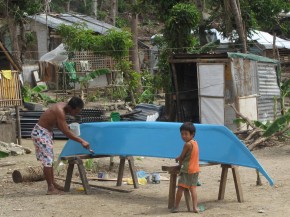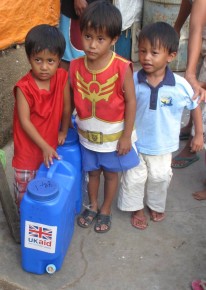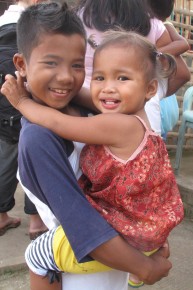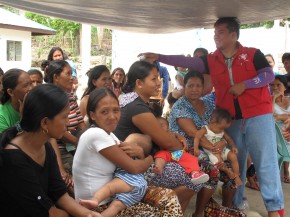The felled trees and fallen telegraphs poles have been cleared and electricity has been restored to the town of Roxas since the last time I was here, but the signs of Typhoon Haiyan are still everywhere to be seen. Back in November when I first visited, the Governor’s office was a hive of activity – 30 organisations were piled into 1 big room working in a frenzy, burly Canadian soldiers were camped out on the balcony sleeping in hammocks, and you couldn’t find a hotel room in town for love nor money. Nearly 3 months on, and the frenetic pace has become more manageable, the urgent needs of food, water and temporary shelter have been met for most people, but that is the relatively straightforward part; now long after media attention has been drawn elsewhere, people have to find a way to build back their lives.

Off the coast of Roxas we visited several islands affected by the typhoon. The first outside help Canas island received was from HMS Illustrious; the inhabitants recounted to us how a helicopter from the ship landed on the beach - “it was like the movies”. It is a small island with only a few hundred people and because of the direction of the storm when it hit the island, the storm surge swept across from both sides, damaging or destroying just about every building.

The sun was shining and the sea was calm when we landed, but the destruction the typhoon had wreaked was still evident. Tarpaulins were fixed over broken roofs, crumpled corrugated iron used as temporary walls. One family proudly showed me their water filter jerrycan DFID had provided. But across the island men were fixing boats and gathering debris from the shoreline, mending, fixing, sawing and hammering; the sounds of people rebuilding their lives.
Visiting some of these more remote islands, you really get a sense of the scale of the typhoon. Miles from Tacloban (blog on my visit there last time here) its impact on these islands here is radically different; when the typhoon hit, places like Canas were left stranded – boats destroyed, houses damaged. But as soon as they can get some basic materials, and boats to resume their livelihoods, they can begin to build back for themselves. In urban areas like Tacloban or Guiuan which were virtually flattened, the sheer scale of trying to clear the rubble, with thousands of people displaced in a small area, the challenges of disease, sanitation, housing, of how people can even begin to earn a living in a city completely destroyed, presents a whole different set of problems.

Back on the mainland, at 8 in the morning in Estancia, inhabitants of the evacuation centre are outside the front of their tents boiling pans of water for breakfast. When the storm hit land here, it took a barge loaded with oil with it, causing an oil spill that has ruined the livelihoods of many of the fisherfolk, and forced thousands to leave their homes because of the damage and toxic chemicals. Nearly 3 months on many still not able to return are living in a tented camp on what used to be the playground area of an adjoining school. Thousands of people across the country still remain in camps like these. Here in Estancia each family has a tent, and the centre has sanitation facilities (provided by UNICEF, supported by DFID) and some electricity, but it's still not exactly the ideal place to bring up a family. Some won't be able to return to their homes as the government seeks to impose a no-build zone next to the ocean to make sure the next time a storm surge hits, people's homes aren’t the first thing in its path; but as they wait for temporary bunkhouses to be built for them, it's an uncertain future.

Further down the road we visit Action Against Hunger nutrition programmes supported by DFID through UNICEF. Mothers queue up patiently, waiting for their babies to be weighed and measured for signs of malnutrition and stunting. Incidents of malnutrition were already high in areas like this before the typhoon hit – as with many of the badly affected areas, it is the most poor and vulnerable who suffer the most, and the boundary between chronic pre-existing poverty and the impact of the typhoon is not always clear. Back on the island of Calagnaan, we'd seen a Save the Children programme funded by DFID through UNICEF which sought to counsel mothers on infant and young child feeding, using the typhoon as an opportunity to make sure those who were vulnerable before the storm are reached. Most of the immediate lifesaving needs have been met, but the challenge is how people can be supported to actually ‘build back better’ for themselves, to use the disaster as an opportunity. There are no easy solutions.
----------------------------------------------------------------------------------
For the latest updates on the UK's response to Typhoon Haiyan visit: https://www.gov.uk/government/news/typhoon-haiyan-latest-updates-on-uk-aid

Recent Comments